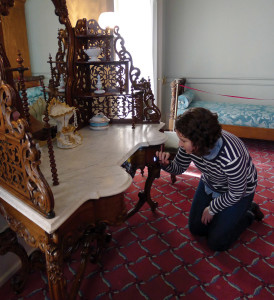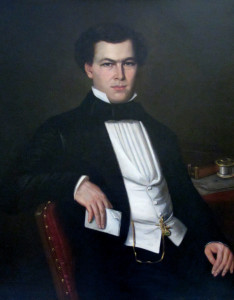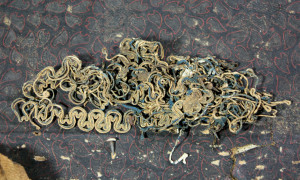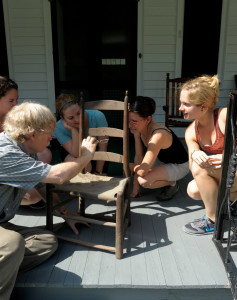Trust Grant Assists Field Work in the Gulf South
EMERGING SCHOLARS > CURATORIAL INTERNSHIP GRANTS
By Caryne Eskridge
Project Director and Research Curator,
Classical Institute of the South
When planning a lengthy sojourn in the Gulf South, the summer is not usually the recommended season to schedule a visit. However, I eagerly relocated to New Orleans in late June 2014, despite the oppressive heat and humidity, to become the first full-time employee of the Classical Institute of the South (CIS), a position created with the generous assistance of a Curatorial Internship Grant from the Decorative Arts Trust’s Emerging Scholars Program.
The CIS was established in 2009 to carry out a comprehensive survey of objects made and used in the Gulf South prior to 1860. Inspired by the pioneering work of MESDA in the southeast, the CIS has sponsored summer field work sessions since 2011. The service of a full-time employee has allowed the organization to make its Gulf South Decorative & Fine Arts Database available online as well as expand its reach for future cataloguing.
The opportunity to help usher the CIS into this significant new phase was too enticing to refuse, even with a firsthand knowledge of the environmental challenges that accompany summertime in the Gulf South. My connection to the CIS extends back to 2012 when I served as a summer fellow. The incredible objects, many of which remain in their original contexts, the stories told by descendants and local experts, and the history and hospitality shared over iced tea, biscuits, and milkshakes ameliorated the difficult conditions.
My first responsibility was to lead the 2014 survey, which included work in Natchez, MS, and Huntsville, AL. Our summer fellows, Lea Lane and Katie McKinney, were both members of the University of Delaware’s Winterthur Program in American Material Culture Class of 2015. Lea and Katie brought complementary interests and expertise, not to mention a tireless work ethic and unending enthusiasm that made the season a great success. Our team cataloged upwards of 250 objects from seven sites: four in Natchez and three in the Huntsville.
The CIS is also dependent upon the generous assistance of regional partners for providing this fodder for our field work. In Natchez, we benefitted from the vast insight and support of Mimi Miller and Jeff Mansell, of the Historic Natchez Foundation and the Natchez National Historical Park, respectively, who both participated in the Trust’s Natchez symposium last fall. While in Huntsville, we were the guests of Trust members Kelly and Randy Schrimsher and Bert Parsons, who graciously introduced us to the collections we inventoried in nearby communities.
An important goal of the survey is to document items that speak to the experience of enslaved peoples in the antebellum Gulf South. In Natchez, we catalogued a punkah cover. A punkah, occasionally called a shoo-fly, is a regional form particular to the South. Essentially a large fan hinged to the ceiling above the dining room table, the punkah is pulled back and forth by a chord on a pulley system, usually the job of a slave standing at the side of the room. It served the dual purposes of cooling guests and keeping insects away from food. This remarkable artifact dates to the 1850s and remains at the location where it was originally installed. Made of an oilcloth-like material with a woven textile ground, the cover features a decorated surface with trim around the edges.
Following the summer survey, my primary objective was the introduction of the CIS’s Gulf South Decorative & Fine Arts Database, the growing online repository of information and photographs collected during our past field surveys. Working with staff at The Historic New Orleans Collection (THNOC), one of our primary institutional partners, I edited and standardized all of the previously collected information and made it accessible through the database, which is part of the Louisiana Digital Library (visit: louisdl.louislibraries.org). The database’s debut was a major milestone for the CIS and, I am confident, for the study of American decorative arts.
To that end, the CIS has already served as a catalyst for acquisitions, exhibitions, and educational programming. A parlor suite inventoried during the inaugural field season in 2011 is the subject of a special exhibition at the New Orleans Museum of Art this year (see in Exhibits); and two pieces of slave livery recorded during that same summer are currently on view in THNOC’s highly regarded show Purchased Lives: New Orleans and the Domestic Slave Trade, 1808–1865. In addition for providing the content for two lectures during the Trust’s successful Natchez symposium, CIS objects were the focus of a lecture I gave at the 2015 Newport Symposium about the connections between Natchez and the North and the decorative arts that made their way to Natchez as a result.
Thanks to the generous support of the Decorative Arts Trust in the creation of a full-time position, a remarkable range of historically significant objects are now accessible online for the use of scholars, historians, and the general public. Working with the CIS has been a thrilling opportunity to bring important yet unpublished decorative arts to light and to share stories about the generations of people who have lived with and cared for them.
SAVE THE DATE
- Special Symposium
“Classical Splendor”
The Philadelphia Museum of Art
November 4, 2016 - New York Antiques Weekend
January 20-21, 2017 - Spring Symposium
Savannah
April 21-24, 2017 - Spring Study Trip Abroad
Scotland
May 14-22, 2017 - Fall Symposium
Hartford & Western Connecticut
September 2017 - Fall Study Trip Abroad
Venice and the Veneto
October 9-16 and 22-29, 2017
By Caryne Eskridge
Project Director and Research Curator,
Classical Institute of the South
When planning a lengthy sojourn in the Gulf South, the summer is not usually the recommended season to schedule a visit. However, I eagerly relocated to New Orleans in late June 2014, despite the oppressive heat and humidity, to become the first full-time employee of the Classical Institute of the South (CIS), a position created with the generous assistance of a Curatorial Internship Grant from the Decorative Arts Trust’s Emerging Scholars Program.
The CIS was established in 2009 to carry out a comprehensive survey of objects made and used in the Gulf South prior to 1860. Inspired by the pioneering work of MESDA in the southeast, the CIS has sponsored summer field work sessions since 2011. The service of a full-time employee has allowed the organization to make its Gulf South Decorative & Fine Arts Database available online as well as expand its reach for future cataloguing.
The opportunity to help usher the CIS into this significant new phase was too enticing to refuse, even with a firsthand knowledge of the environmental challenges that accompany summertime in the Gulf South. My connection to the CIS extends back to 2012 when I served as a summer fellow. The incredible objects, many of which remain in their original contexts, the stories told by descendants and local experts, and the history and hospitality shared over iced tea, biscuits, and milkshakes ameliorated the difficult conditions.
My first responsibility was to lead the 2014 survey, which included work in Natchez, MS, and Huntsville, AL. Our summer fellows, Lea Lane and Katie McKinney, were both members of the University of Delaware’s Winterthur Program in American Material Culture Class of 2015. Lea and Katie brought complementary interests and expertise, not to mention a tireless work ethic and unending enthusiasm that made the season a great success. Our team cataloged upwards of 250 objects from seven sites: four in Natchez and three in the Huntsville.
The CIS is also dependent upon the generous assistance of regional partners for providing this fodder for our field work. In Natchez, we benefitted from the vast insight and support of Mimi Miller and Jeff Mansell, of the Historic Natchez Foundation and the Natchez National Historical Park, respectively, who both participated in the Trust’s Natchez symposium last fall. While in Huntsville, we were the guests of Trust members Kelly and Randy Schrimsher and Bert Parsons, who graciously introduced us to the collections we inventoried in nearby communities.
An important goal of the survey is to document items that speak to the experience of enslaved peoples in the antebellum Gulf South. In Natchez, we catalogued a punkah cover. A punkah, occasionally called a shoo-fly, is a regional form particular to the South. Essentially a large fan hinged to the ceiling above the dining room table, the punkah is pulled back and forth by a chord on a pulley system, usually the job of a slave standing at the side of the room. It served the dual purposes of cooling guests and keeping insects away from food. This remarkable artifact dates to the 1850s and remains at the location where it was originally installed. Made of an oilcloth-like material with a woven textile ground, the cover features a decorated surface with trim around the edges.
Following the summer survey, my primary objective was the introduction of the CIS’s Gulf South Decorative & Fine Arts Database, the growing online repository of information and photographs collected during our past field surveys. Working with staff at The Historic New Orleans Collection (THNOC), one of our primary institutional partners, I edited and standardized all of the previously collected information and made it accessible through the database, which is part of the Louisiana Digital Library (visit: louisdl.louislibraries.org). The database’s debut was a major milestone for the CIS and, I am confident, for the study of American decorative arts.
To that end, the CIS has already served as a catalyst for acquisitions, exhibitions, and educational programming. A parlor suite inventoried during the inaugural field season in 2011 is the subject of a special exhibition at the New Orleans Museum of Art this year; and two pieces of slave livery recorded during that same summer are currently on view in THNOC’s highly regarded show Purchased Lives: New Orleans and the Domestic Slave Trade, 1808–1865. In addition for providing the content for two lectures during the Trust’s successful Natchez symposium, CIS objects were the focus of a lecture I gave at the 2015 Newport Symposium about the connections between Natchez and the North and the decorative arts that made their way to Natchez as a result.
Thanks to the generous support of the Decorative Arts Trust in the creation of a full-time position, a remarkable range of historically significant objects are now accessible online for the use of scholars, historians, and the general public. Working with the CIS has been a thrilling opportunity to bring important yet unpublished decorative arts to light and to share stories about the generations of people who have lived with and cared for them.





